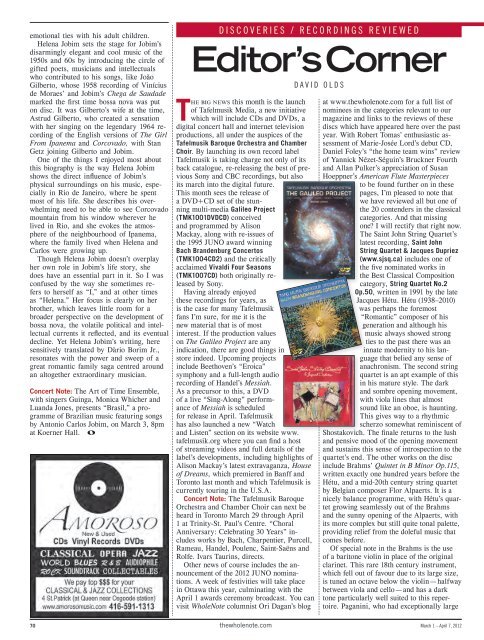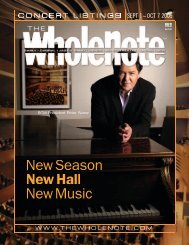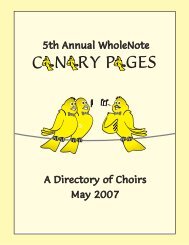Create successful ePaper yourself
Turn your PDF publications into a flip-book with our unique Google optimized e-Paper software.
emotional ties with his adult children.Helena Jobim sets the stage for Jobim’sdisarmingly elegant and cool music of the1950s and 60s by introducing the circle ofgifted poets, musicians and intellectualswho contributed to his songs, like JoãoGilberto, whose 1958 recording of Viníciusde Moraes’ and Jobim’s Chega de Saudademarked the first time bossa nova was puton disc. It was Gilberto’s wife at the time,Astrud Gilberto, who created a sensationwith her singing on the legendary 1964 recordingof the English versions of The GirlFrom Ipanema and Corcovado, with StanGetz joining Gilberto and Jobim.One of the things I enjoyed most aboutthis biography is the way Helena Jobimshows the direct influence of Jobim’sphysical surroundings on his music, especiallyin Rio de Janeiro, where he spentmost of his life. She describes his overwhelmingneed to be able to see Corcovadomountain from his window wherever helived in Rio, and she evokes the atmosphereof the neighbourhood of Ipanema,where the family lived when Helena andCarlos were growing up.Though Helena Jobim doesn’t overplayher own role in Jobim’s life story, shedoes have an essential part in it. So I wasconfused by the way she sometimes refersto herself as “I,” and at other timesas “Helena.” Her focus is clearly on herbrother, which leaves little room for abroader perspective on the development ofbossa nova, the volatile political and intellectualcurrents it reflected, and its eventualdecline. Yet Helena Jobim’s writing, heresensitively translated by Dàrio Borim Jr.,resonates with the power and sweep of agreat romantic family saga centred aroundan altogether extraordinary musician.Concert Note: The Art of Time Ensemble,with singers Guinga, Monica Whicher andLuanda Jones, presents “Brasil,” a programmeof Brazilian music featuring songsby Antonio Carlos Jobim, on March 3, 8pmat Koerner Hall.Editor’s CornerDAVID OLDSThe big news this month is the launchof Tafelmusik Media, a new initiativewhich will include CDs and DVDs, adigital concert hall and internet televisionproductions, all under the auspices of theTafelmusik Baroque Orchestra and ChamberChoir. By launching its own record labelTafelmusik is taking charge not only of itsback catalogue, re-releasing the best of previousSony and CBC recordings, but alsoits march into the digital future.This month sees the release ofa DVD+CD set of the stunningmulti-media Galileo Project(TMK1001DVDCD) conceivedand programmed by AlisonMackay, along with re-issues ofthe 1995 JUNO award winningBach Brandenburg Concertos(TMK1004CD2) and the criticallyacclaimed Vivaldi Four Seasons(TMK1007CD) both originally releasedby Sony.Having already enjoyedthese recordings for years, asis the case for many Tafelmusikfans I’m sure, for me it is thenew material that is of mostinterest. If the production valueson The Galileo Project are anyindication, there are good things instore indeed. Upcoming projectsinclude Beethoven’s “Eroica”symphony and a full-length audiorecording of Handel’s Messiah.As a precursor to this, a DVDof a live “Sing-Along” performanceof Messiah is scheduledfor release in April. Tafelmusikhas also launched a new “Watchand Listen” section on its website www.tafelmusik.org where you can find a hostof streaming videos and full details of thelabel’s developments, including highlights ofAlison Mackay’s latest extravaganza, Houseof Dreams, which premiered in Banff andToronto last month and which Tafelmusik iscurrently touring in the U.S.A.Concert Note: The Tafelmusik BaroqueOrchestra and Chamber Choir can next beheard in Toronto March 29 through April1 at Trinity-St. Paul’s Centre. “ChoralAnniversary: Celebrating 30 Years” includesworks by Bach, Charpentier, Purcell,Rameau, Handel, Poulenc, Saint-Saëns andRolfe. Ivars Taurins, directs.Other news of course includes the announcementof the 2012 JUNO nominations.A week of festivities will take placein Ottawa this year, culminating with theApril 1 awards ceremony broadcast. You canvisit WholeNote columnist Ori Dagan’s blogat www.thewholenote.com for a full list ofnominees in the categories relevant to ourmagazine and links to the reviews of thesediscs which have appeared here over the pastyear. With Robert Tomas’ enthusiastic assessmentof Marie-Josée Lord’s debut CD,Daniel Foley’s “the home team wins” reviewof Yannick Nézet-Séguin’s Bruckner Fourthand Allan Pulker’s appreciation of SusanHoeppner’s American Flute Masterpiecesto be found further on in thesepages, I’m pleased to note thatwe have reviewed all but one ofthe 20 contenders in the classicalcategories. And that missingone? I will rectify that right now.The Saint John String Quartet’slatest recording, Saint JohnString Quartet & Jacques Dupriez(www.sjsq.ca) includes one ofthe five nominated works inthe Best Classical Compositioncategory, String Quartet No.2Op.50, written in 1991 by the lateJacques Hétu. Hétu (1938–2010)was perhaps the foremost“Romantic” composer of hisgeneration and although hismusic always showed strongties to the past there was aninnate modernity to his languagethat belied any sense ofanachronism. The second stringquartet is an apt example of thisin his mature style. The darkand sombre opening movement,with viola lines that almostsound like an oboe, is haunting.This gives way to a rhythmicscherzo somewhat reminiscent ofShostakovich. The finale returns to the lushand pensive mood of the opening movementand sustains this sense of introspection to thequartet’s end. The other works on the discinclude Brahms’ Quintet in B Minor Op.115,written exactly one hundred years before theHétu, and a mid-20th century string quartetby Belgian composer Flor Alpaerts. It is anicely balance programme, with Hétu’s quartetgrowing seamlessly out of the Brahmsand the sunny opening of the Alpaerts, withits more complex but still quite tonal palette,providing relief from the doleful music thatcomes before.Of special note in the Brahms is the useof a baritone violin in place of the originalclarinet. This rare 18th century instrument,which fell out of favour due to its large size,is tuned an octave below the violin — halfwaybetween viola and cello — and has a darktone particularly well suited to this repertoire.Paganini, who had exceptionally large70 thewholenote.comMarch 1 – April 7, 2012
















